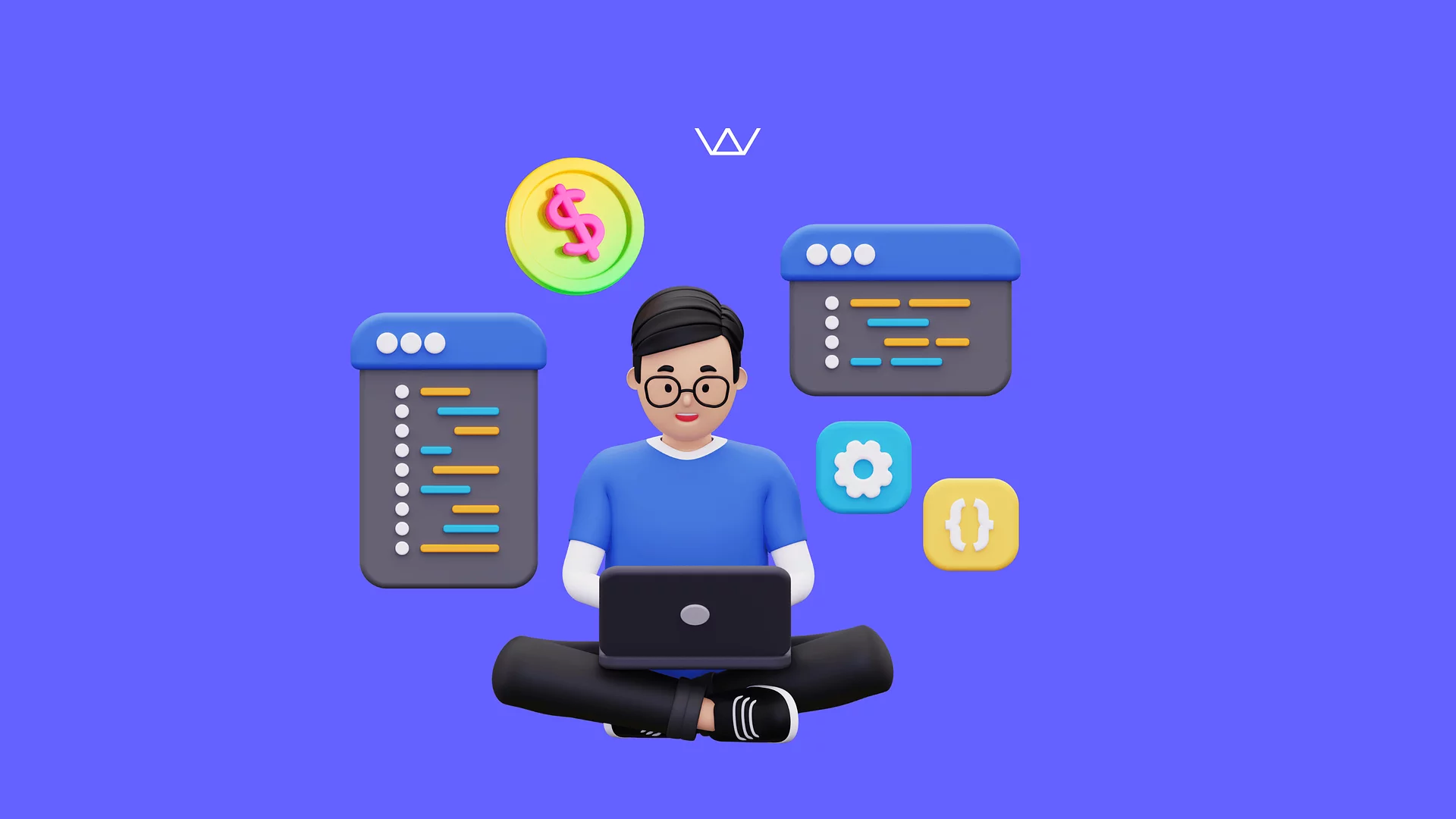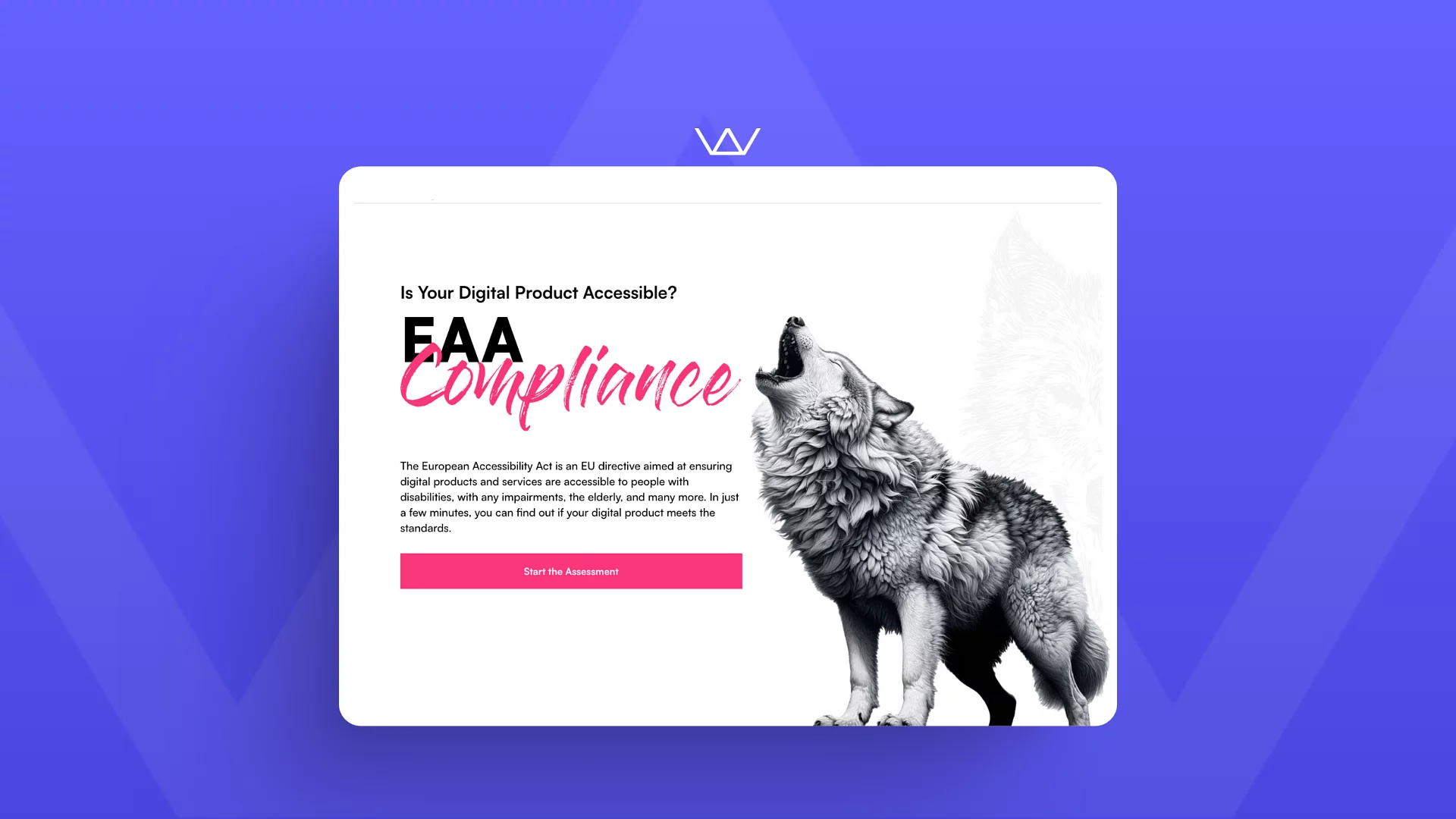
How Much Does Web Development Cost? A Complete Guide
Oana
Marketing Specialist
10 min
Feb 26, 2025
Building a website is like building a house 🏠—you need a solid foundation, great design, and ongoing maintenance to keep it running smoothly. And if you ever went through this process, you know that many aspects are involved in the final cost.
It goes the same for web development services. But how much does a website cost? Well, the answer isn’t as simple as you might hope. 😅
Overall, the cost of building a website varies based on complexity, features, design, ongoing support, and, of course, if you choose to hire an in-house professional web developer, a freelancer to do all the work or collaborate with a web development company like us.
But whether you’re a startup, a small business, or an enterprise, understanding website development pricing will help you plan your budget wisely. 📝
In this guide, we’ll break down the cost of web development, what factors influence it, and what you should expect when hiring a web development agency like Wolfpack Digital.
Let’s dive in! 🤿
First thing's first: Custom Website Development or No-code/Low-code?
To better understand the budget you'll need for your website, it's important to first identify your needs and set your priorities. When it comes to building a website, business owners have two primary options: using a no-code/low-code platform or opting for custom website development services.
Are you looking for a fully customized experience tailored to your unique vision or a faster, budget-friendly approach with no-code/low-code platforms? There's a solution for every need. But what's the right fit for your project? Let's break it down.
Custom Web Development is like having a tailor craft a suit specifically for you—it’s built from the ground up to match your brand, business goals, and user experience requirements. This approach requires more knowledge and can be more time-consuming, but it allows for custom solutions and scalability. This is ideal for businesses that require complex functionality or custom integrations.
Pros:
✅ Flexibility & Scalability – Custom-built websites can grow with your business, adapting to new features, integrations, and increased traffic over time.
✅ Unique Design & User Experience – No templates here! A custom solution ensures your website reflects your brand identity and offers a custom UX/UI.
✅ Advanced Functionality – Whether you need a complex e-commerce platform, a dynamic SaaS platform, or an AI-powered app, custom development gives you total control over features.
✅ Better Performance & Security – With optimized code and built-in security measures, custom sites often outperform and outlast template-based alternatives.
Cons:
🔴 Considerations: Custom development requires a more significant investment (both time and money), but if you’re looking for a powerful, long-term solution, it’s worth it.
Here are a couple of examples of custom web development projects from our portfolio:
CorribOil is an energy provider from Ireland with nearly 60 locations nationwide, with a deli or a bakery included. Our solution was a platform designed to simplify everyday needs for customers, from orders to managing loyalty rewards. Integrated with top-tier third-party services, the platform ensures smooth transactions, insightful analytics, and a personalized user experience.
Equality AI brings modern technology methods by developing an AI that reduces the risk of biased outcomes in order to solve healthcare's most challenging problems. We helped the Equality AI team with their web platform, which provides fairness-based machine learning capabilities for data scientists to develop and collaborate with clinical teams to decrease the risk of discrimination in clinical decision-making algorithms.
No-code and low-code platforms allow businesses to build web applications without (or with minimal) traditional coding. Think of it as assembling a website using high-quality building blocks instead of constructing it from scratch. They are ideal for small businesses or individuals who want to create a simple website quickly.
Pros:
✅ Faster Development – Launch your website or app in weeks instead of months, perfect for MVPs (Minimum Viable Products) or internal tools.
✅ Cost-Effective – Since development time is reduced, so are costs. Ideal for startups and small businesses with limited budgets.
✅ User-Friendly – No-code platforms (like Wix/WordPress, Shopify, Magento, etc.) empower non-developers to create and maintain websites without deep technical knowledge.
✅ Pre-Built Integrations – Many platforms come with plug-and-play features like payment gateways, CRMs, and automation tools.
Cons:
🔴 Considerations: While these platforms are great for simpler projects, they have limitations in customization, scalability, and security. For example, if you want to add a new feature with a custom UI component like a calendar, a graph, or a chat with some special visual elements, you'd be relying on other developers to build it themselves, or you will still need to write code using the platform's resources. As your business grows, you may find yourself needing a custom-built solution.
Here are a few examples of no-code/low-code platforms:
UI Bakery - A low-code platform designed for building internal tools and business apps quickly. It offers a drag-and-drop UI builder, integrations with databases and APIs, and automation features.
Appsmith - An open-source, low-code platform for building internal applications. Developers can quickly create dashboards, admin panels, and CRUD apps with pre-built UI components and database connections.
Wix Studio - An advanced website builder that combines Wix’s no-code flexibility with professional design and development capabilities. Perfect for designers, freelancers, and agencies looking for a responsive and creative web solution.
Shopify - A leading e-commerce platform that allows businesses to create, manage, and scale online stores with ease. It offers built-in payment processing, marketing tools, and a vast app marketplace.
Magento - A robust and flexible open-source e-commerce platform, now part of Adobe Commerce. It’s highly customizable and suited for businesses looking for advanced features, scalability, and integrations.
Let's talk about the factors that influence the overall web development costs
There are many layers involved in developing a website, and all of them influence the final costs.
Now that you know the difference between a custom-developed platform and one using no-code/low-code tools, we can tackle the type of website you need for your business.
1. Type of Website
Are you building a simple blog, a business website, an e-commerce store, or a complex web application? Each comes with different development needs and website development costs.
For custom web development, hiring professional web designers and developers can significantly impact the quality and functionality of these websites, with costs varying based on the complexity and customization required.
- Landing page (e.g., presentation website, personal blog, portfolio): $1,000 – $5,000
- Business website (e.g., small business website): $5,000 – $20,000
- eCommerce website (e.g., an online store with different functionalities): $10,000 – $50,000+
- Custom web application (e.g., SaaS platform, marketplace): $20,000 – $150,000+
2. UX/UI Design Costs
A well-designed website isn’t just about aesthetics—it impacts user engagement and conversions. Having a web designer who can create a custom UI/UX design can significantly enhance the user experience and ensure a unique, professional look. The cost of UX/UI design depends on the level of customization.
UX/UI Design usually takes about 10-15% of the total web development cost.
3. Web Development Complexity
The more features you need, the higher the cost to build a website will be. Some features that increase costs include:
- E-commerce functionality (shopping cart, payment gateway): $5,000 – $20,000+
- Membership portals & user logins: $3,000 – $10,000
- Custom dashboards & admin panels: $5,000 – $15,000
- Integration with third-party services (APIs, CRMs, payment gateways): $3,000 – $20,000+
4. Quality Assurance and why it’s important
A well-designed website or web platform is only as strong as its performance, security, and user experience—and that's where Quality Assurance (QA) comes in. Without proper QA testing, even the most beautifully designed websites can suffer from bugs, security vulnerabilities, slow load times, or broken functionality, leading to frustrated users and lost business opportunities.
QA in web development is the process of testing and validating a website or web platform to ensure it meets technical, functional, and business requirements before going live. QA specialists work alongside developers and designers to identify and fix potential issues early, ensuring a smooth, error-free experience for users.
There are many QA testing methods used in web development, and you need to keep in mind that the types of testing you choose will influence the development budget:
- Manual Testing: QA specialists manually check every function, button, and page to spot errors.
- Automated Testing: AI-driven tools test site performance, load times, and security vulnerabilities.
- Performance Testing: Ensures fast load times and scalability under heavy traffic.
- Security Testing: Detects potential risks and ensures strong data protection.
- Usability Testing: Ensures a smooth, intuitive experience for users.
Skipping QA in web development can lead to costly fixes, frustrated users, and lost revenue. Investing in QA testing throughout the development process ensures that your website or web app is high-quality, secure, and user-friendly—right from launch. If you want to read more about the QA process, we have a dedicated article here.
Usually, QA takes about 15-20% of the total development budget.
5. Website Maintenance
Congrats! You're ready to launch your new and beautiful website. But launching a website or web app is just the beginning.
To ensure long-term success, regular maintenance is essential. Without ongoing updates, security patches, and performance monitoring, even the best-built platforms can become slow, outdated, or vulnerable to cyber threats.
Why does website maintenance matter?
- Security updates 🔒 – Cyber threats evolve constantly. Regular maintenance ensures your website stays protected from vulnerabilities and data breaches.
- Bug fixes & performance optimization ⚡ – Over time, minor glitches or slowdowns can appear. Routine updates improve speed, stability, and overall user experience.
- Compatibility with new technologies 📱 – Browsers, operating systems, and third-party integrations frequently update. Maintenance ensures your app remains compatible and functional across all platforms.
- Scalability & feature enhancements 📈 – As your business grows, so should your website. Ongoing maintenance allows for seamless updates and new feature rollouts without major disruptions.
The yearly cost of app maintenance can range from 10-20% of the entire web development cost.
A well-maintained website or app is faster, more secure, and future-proof. At Wolfpack Digital, we offer continuous maintenance and support to keep your web app running at its best—because digital success doesn't stop at launch!
6. Project Management
Building a website or web app involves multiple moving parts—design, development, testing, and deployment. Without proper project management, things can quickly spiral into missed deadlines, miscommunication, and budget overruns.
- Clear roadmap & timelines ⏳ – A structured workflow ensures that every phase—planning, design, development, and testing—stays on track.
- Efficient communication 📢 – Project managers bridge the gap between clients, designers, and developers, ensuring everyone is aligned on goals and expectations.
- Risk management 🚧 – Identifying and addressing potential roadblocks early prevents costly delays and unexpected challenges.
- Quality control 🔍 – Regular checkpoints and testing guarantee that the final product meets high performance, security, and usability standards.
- Budget & resource optimization 💰 – Proper planning ensures that resources are used effectively, avoiding waste and overspending.
Strong project management keeps web development organized, efficient, and goal-focused.
At Wolfpack Digital, we combine methodologies like Agile and Scrum with clear communication to deliver high-quality projects on time and within budget—because success is built on structure.
Project management usually accounts for about 20-25% of the total web development cost.
7. Hiring a Web Development Team vs. a Freelancer
Choosing between hiring a freelancer or a web development agency depends on your project’s complexity, budget, and long-term goals. Let’s break down the differences so you can make an informed decision.
Freelancer: A freelancer is an independent web developer or designer who works solo. They’re a great fit for small-scale projects that don’t require a large team.
✅ Pros:
- Lower Cost – Freelancers generally charge less than agencies since they have lower overhead costs.
- Direct Communication – You work directly with the developer, making the process more personal.
- Flexible & Agile – Freelancers often have more flexible schedules and can adapt to project needs quickly.
- Best for Simple Projects – Ideal for portfolio sites, personal blogs, or small business websites.
❌ Cons:
- Limited Skill Set – A freelancer may specialize in one area (e.g., front-end development) but lack expertise in backend, UI/UX design, or security.
- Slower Development – Since one person handles everything, progress can be slower, especially if they have multiple clients.
- Lack of Long-Term Support – After launching the website, ongoing maintenance and updates may be challenging if the freelancer is unavailable.
- Higher Risk – If a freelancer disappears mid-project, you might be left scrambling to find a replacement.
Best for:
- Small projects (basic websites, landing pages, personal blogs).
- Startups testing an MVP (minimum viable product) with a limited budget.
- Businesses needing minor updates or improvements to an existing site.
Web Development Agency: A web development agency is a team of professionals, including developers, designers, project managers, and QA specialists. They follow a structured development process to deliver high-quality, scalable digital products.
✅ Pros:
- Complete Skill Set – Agencies provide expertise in frontend and backend development, UI/UX design, quality assurance, and more.
- Structured & Scalable – Agencies follow a well-defined workflow, ensuring project efficiency, milestones, and deadlines are met.
- Predictable - Web development agencies create a roadmap and resource allocation, so you don't need to worry about managing the development team, as the start-to-end process is handled by a project or product manager.
- Higher Quality & Reliability – With multiple professionals working on your project, you get a polished, high-performance website with fewer bugs.
- Long-Term Support & Maintenance – Many agencies offer ongoing support, updates, and security maintenance post-launch.
- Best for Complex Projects – If you need a custom web application, e-commerce store, or SaaS platform, agencies ensure scalability and robustness.
❌ Cons:
- Higher Cost – Agencies have overhead costs (office space, tools, salaries), making them more expensive than freelancers.
- Less Personal Interaction – You usually communicate through a project manager rather than directly with developers.
- Longer Onboarding Process – Since agencies follow structured workflows, initial discussions, documentation, and approvals may take longer than with a freelancer.
Best for:
- Medium to large-scale projects (custom web apps, marketplaces, e-commerce platforms).
- Businesses that need ongoing support & security maintenance.
- Companies that prioritize quality, performance, and scalability.
- Startups and enterprises looking for a long-term development partner.
While hiring a freelancer might seem more affordable, working with a professional web development agency ensures higher quality, scalability, and post-launch support.
At Wolfpack Digital, we specialize in custom web development with a dedicated team throughout the entire development lifecycle: design, development, QA, maintenance, and support. If you're looking for a trusted tech partner, don't hesitate to get in touch with us!

The Hidden Costs of Website Development
When estimating the cost of a website, don’t forget these ongoing expenses:
Infrastructure & Domain Costs
- Domain name: $10 – $50/year
- Web hosting (shared, VPS, dedicated): A web host is a service that provides the necessary space on a server for websites, enabling users worldwide to access the site. Web hosting is a fundamental ongoing cost associated with maintaining a website, alongside other elements like domain names and SSL certificates. A few popular options are Google Cloud, AWS, Microsoft Azure, and Heroku for simpler projects. Such cloud providers come with a vast range of other services that can add to that cost (database hosting, networking security functionalities, file storage, etc.). AWS, for example, offers a pricing calculator that can help you estimate this cost.
- small size web apps: ~25-75$
- medium size web apps: 200-800$
- large scale web apps: +1000$
- SSL certificate (for security): $50 – $100/year
SEO
A website without traffic is like a shop in the middle of nowhere—no matter how great your products or services are, people won’t find them unless you guide them there. This is where SEO (Search Engine Optimization) comes into play. SEO (Search Engine Optimization) isn’t something to be added after a website is built—it should be a core part of the web development process from the start. Integrating SEO during development ensures that your website is not only visually appealing but also search engine-friendly, fast, and user-centric.
Here’s why:
- SEO-friendly structure from the ground up - A well-structured website makes it easier for search engines to crawl and index your pages, which directly impacts rankings.
- Faster page speeds = higher rankings - Site speed is a Google ranking factor and a critical element of user experience. Slow-loading websites lead to higher bounce rates and lower conversions.
- Better User Experience (UX) & lower bounce rates - Google prioritizes websites that provide a good user experience.
- Technical SEO foundations are harder to fix later - Some SEO elements are difficult and expensive to fix post-launch.
How to Optimize Website Development Costs Without Sacrificing Quality
Here are some ways to optimize costs:
✅ Plan ahead—The first step is to have your requirements well-structured, with a clear broken-down estimation, an implementation roadmap, and clear budget tracking. All of these will help prevent unexpected costs.
✅ Prioritize MVP (Minimum Viable Product)—launch with core features first, validate, then scale.
✅ Work with an experienced web development agency to avoid costly rework. Sometimes, the cheaper options may sound good in theory, but in practice, cheaper options usually come with less-quality results and, therefore, the need to invest additional budget for fixing issues, re-writing code, or even worse, starting from 0 again.
✅ Use no-code/low-code platforms (e.g., Wix, WordPress, Shopify) instead of custom-built CMS. These options work well for very simple websites.
Conclusion: How Much Should You Budget for Your Website?
Building a website is more than just designing pages—it’s about creating a functional, high-performing, and scalable digital presence that meets your business goals. Whether you're launching a simple business website, an e-commerce store, or a custom web platform, the cost and approach will vary based on complexity, functionality, and long-term needs.
Key Takeaways:
- You can choose between custom web development for full flexibility or no-code/low-code solutions for a faster, budget-friendly approach.
- The factors that influence the final budget for your project are the type of website, UX/UI design, complexity, QA, project management, maintenance, infrastructure and domain costs, and SEO.
- While freelancers offer affordability and agility, a web development agency provides expertise, scalability, and long-term support.
- A few tips & tricks to help you optimize the budget and process.
At Wolfpack Digital, we specialize in custom web development that balances cost-efficiency with high-quality results. Here, you can see the web development projects we delivered in our 10 years of experience.
Whether you need a simple business website or a complex platform, we’ll help you build a powerful online presence.
Need a custom quote? Contact us today to discuss your web development needs!
pack knowledge

Is your digital product ready for the European Accessibility Act (EAA)? Take the assessment to find out!
Oana
Marketing Specialist
5 min
Mar 20, 2025
With the 2025 deadline approaching, ensuring your website or app meets accessibility standards is important. Our free EAA assessment helps you quickly check compliance and identify areas for improvement. At Wolfpack Digital, we specialize in making digital products accessible, user-friendly, and future-proof. Take the assessment today and ensure your platform is inclusive for all users!

UX/UI Design: Collaborating with a Software Development Agency When You're New to the Game
Cristian
Head of UX/UI Design
7 min
Feb 18, 2025
This guide will walk you through every stage of the UX/UI design process, from the initial conversation to launching a product you can be proud of. Understanding the design thinking process, which includes empathizing, defining, ideating, prototyping, and testing, is crucial for creating user-friendly products and solutions.

What is a Minimum Viable Product, and How Does it Differ from a Proof of Concept (PoC)?
Oana
Marketing Specialist
2 min
Mar 5, 2025
Learn the difference between a PoC and an MVP for your startup and when should you build one!


Brief us and let’s work together
